PC Gamer plays: Last Year, Cardpocolypse, Sayonara Wild Hearts, and The Witcher 3
Stories from the games we've been interested in lately.
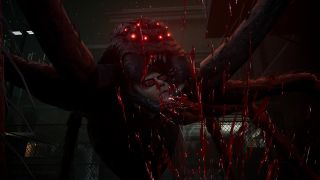
Each month in PC Gamer magazine we devote a few pages to a section we like to call 'now playing', which features stories from our writers about games they have been enjoying recently. In this edition we take a look at Last Year, Cardpocalypse, Sayonaara Wild Hearts and The Witcher 3.
Last Year gets closer to emulating a slasher movie than most—James Davenport
I didn’t belong to any particular clique in school, but Last Year lets me live out that—now that I’m saying it out loud—pretty abnormal fantasy. But it also punishes me for wanting to in the first place, often by A) feeding me to a large spider B) placing my skull between the large, meaty fists of a giant, or C) uh, well, hooks. So, so many hooks.
Yeah, it’s another asymmetrical monsters vs men game, but Last Year doesn’t just copy Dead by Daylight or Left 4 Dead. It takes the conceit, a genre all its own at this point, and makes the monster an offensive level editor with a messed up suit and the teens focused, class-oriented (get it? Because school!) teammates. To be even more reductive, it’s a light level editor (monster) against five fragile testers (teens).
Here’s what I mean: each match, five teen survivors, each their own horror movie cliche, picks a class and sets out into the level with a few typical horror movie objectives, like finding batteries to start a generator that opens a door and lets them escape. The four classes make up a team composition that, together, can foresee and repel any cleverly placed trap or monster attack. The scout can ping traps and tell if the monster is close, while the medic and assault classes work... well, pretty much how you’d expect. Crafting materials are strewn about the level, often in precarious people-separating places, that allow players to make crucial items and weapons: hockey sticks, smoke bombs, flamethrowers, that sort of thing. It’s that Left 4 Dead item management team meta, but deeper and wider and much more dependent on successful team coordination.
The monster (there are four types now, with the spider the newest addition) gets to play a demigod in order to even the odds against a team of five potentially well-equipped and communicative teens. As long as the monster isn’t in anyone’s line of sight, it can despawn into something called Predator Mode. From this invisible no-clip adjacent overview, they can do horror movie stuff.
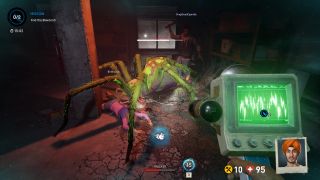
All that complexity makes it a necessity to play with friends, or at least communicative players on the same page. Any gap in the teen teamwork is easily exploited by the monster. It doesn’t help that there’s no tutorial to teach survivors how to work with one another either. Every third match with randos ends in the first few minutes because no one has a clue what’s going on.
But when it works, Last Year brushes up closer to the feeling of being in a slasher flick than any other game of its type. Pounding synth-driven music and the ambience of whimpering teens help nail the oppressive atmosphere. It all works well enough that I still revel in watching a spider bite my head off—as long as they’ve earned it.
The biggest gaming news, reviews and hardware deals
Keep up to date with the most important stories and the best deals, as picked by the PC Gamer team.
The joys of getting messy in Cardpocolypse—Robin Valentine
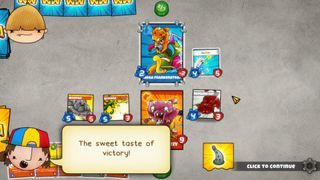
For players of a certain age, there’s an easy nostalgia to Cardpocalypse’s premise. You play a kid at a school where everyone’s obsessed with a collectable card game starring weird, animal-like monsters—in other words, a throwback to Pokemon’s utter domination of the playground zeitgeist in the late-90s.
But that set-up serves to do more than just evoke happy memories. By presenting its ‘Power Pets’ card battles from the perspective of a group of enthusiastic kids, it gives itself permission to be messy. Children don’t spend their time worrying about balance in games, or finding the most precise, efficient combos. They don’t religiously follow the rules, or pore over FAQs online for the latest tweaks.
There’s only one rule that kids follow: the rule of cool. Especially in the period in which the game is set, the community that defined that rule wasn’t a global one, it was local. What was fair play and what wasn’t, what made sense and what didn’t, it was up to you and your friends.
And so it is in Cardpocalypse. The kids at protagonist Jess’ school love playing Power Pets, but even more so they love making it their own. They trade not just in cards, but in stickers—it’s agreed that you can stick new numbers over your favourite pet’s stats to buff them, and even give them a new name. Thanks to an article in the official magazine, it’s also considered kosher to create your own new cards from scratch, as long as you can do a convincing enough crayon drawing to illustrate it.
Cards are coveted, but not hoarded in pursuit of a complete collection. Instead they constantly change hands—traded back and forth, used as currency, borrowed, stolen. If you want a particular card, you’ve got to find a kid who’s got it, and give him something he wants. Maybe that’s a card of equivalent rarity—but, equally, maybe it’s just a fistful of chocolate bars.
I love a deep and straight-faced strategy game as much as the next PC gaming magazine editor, but there’s something wonderfully freeing about Cardpocalypse’s anarchic approach. It conjures up nostalgia not just for a particular time and place, but for an entirely different attitude to gaming—one based in youthful curiosity and wonder. We could all do with a little more of that in our lives, eh?
Sayonara Wild Hearts is en pointe with its speedy transitions—Rachel Watts
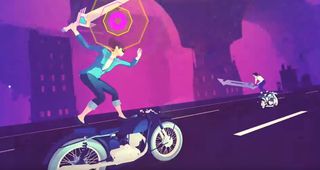
I’m so glad this gorgeous indie made the leap from consoles, travelled full speed through cyberspace, and skidded to a timely halt on Steam. It’s a rhythm action game about fast bikes, giant swords, lost loves, and magical girl transformations. It’s free-spirited and energetic, and it’s pop soundtrack buzzes with energy.
On paper it sounds like a lot to keep up with, but Sayonara Wild Hearts is great at tying all of its ideas together neatly and coherently. In this universe, contemporary ballet is a rather more action-packed practice than it is in ours, and the game uses the grace of ballet choreography to create seamless transitions and a thematic throughline to its setpieces. The result is masterfully smooth, speedy gameplay that doesn’t give you whiplash.
The story follows a young woman who has had her heart broken, and goes on a journey to accept herself and learn to love again. As part of her journey, she must chase down and defeat a number of bosses in a vibrant dreamscape of pinks, purples and blues. After a gentle tutorial that uses Debussy’s Clair de Lune, a song that many ballet dancers have performed, you’re launched into the action.
All of the levels from Sayonara Wild Hearts’ repertoire have multiple different game modes, and it switches between them without breaking pace. One moment you’re dodging incoming enemy missiles, then suddenly you’ll be challenged with some rhythm QTEs, and in another moment you’ll leap off the back of your bike and straight into a duel.
It’s dazzling and spectacular, like something you would see in a Cirque du Soleil performance, and Sayonara Wild Hearts never leaves you behind. There’s a constant rush of landscapes, items and colours—but the game takes it all in its perfectly choreographed stride. Your character’s fluid ballet movements are always the thing to carry you smoothly through from one sequence to the next.
In one scene, she’s gracefully pirouetting out of the way of enemy attacks while leaping effortlessly and the camera follows her movements. She doesn’t just jump out of the way, she leaps and flips with elegance and poise. As she spins out of the way of the last threat, she spins to land back on her already moving motorbike and speeds away, already in position for the next sequence. It’s all in one elegantly smooth motion, and this transition makes the movement between the different sequences as fluid as possible.
There’s no need for the game to pause and adjust, it just carries the player through to the next section in a rush of excitement. Sayonara Wild Hearts’ love of ballet means that it doesn’t have to put the breaks on its speedy visuals. Its burst of ideas and expression all flows together through its fluid transitions, meaning you’re never left behind.
Getting tossed a coin in The Witcher 3—Alistair Jones
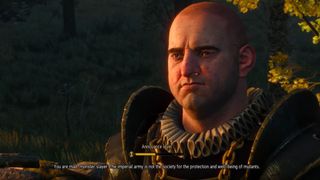
It’s been weeks since I watched Netflix’s The Witcher, and I still can’t get Jaskier’s ‘Toss a Coin to Your Witcher’ out of my head. His fantasy banger echoes through me, haunting my every waking moment. So in an attempt to break the spell he’s clearly cast on me, I decide to do as he says, returning to The Continent to help Geralt earn a little extra pocket money.
The only problem there is that my version of Geralt is currently chilling out in sunny Toussaint in the gardens of his fully refurbished vineyard. That doesn’t sound like the down-on-his-luck monster hunter from Jaskier’s song, so I load up an earlier save and find a dishevelled and impoverished Witcher standing miserably in the rain beside a lake in Velen instead. Much better.
With little more than a handful of Orens to my name, I head towards a nearby village. When I arrive, I head straight for the noticeboard, and discover that the only Witcher contract available concerns someone called Jenny of the Woods. I ask the village’s leader about her, and negotiate my (substantial) fee. He’s not happy, but I’m not about to let Jaskier get the better of me. I head off to find Jenny, but soon discover that she’s met an untimely end and transformed into a horrible—and very angry—Nightwraith. I quickly find out that I’m comically under- levelled for the ensuing fight, but I eventually vanquish Jenny and collect my reward.
As I head out of the village, I’m ambushed by a band of deserters. As much as I’m loathe to even pick up my sword if I’m not getting paid for it, they’re a tenacious bunch, and I’m forced to fight them off. To ensure I don’t come away empty handed, I pick their corpses clean and sell everything to a conveniently-placed travelling merchant. With a few more coins clinking in my pockets, I head off in search of my next contract.
I don’t have to go far. Just outside a nearby fishing village, I find a Nilfgaardian captain searching for a missing patrol. He thinks monsters are to blame, but then gets upset when I try and charge him nearly double the going rate to deal with them. I’m forced to accept his paltry offering and head off in search of the soldiers, but I can’t help but feel short-changed. Arriving at the patrol’s last known location, I find a band of ghouls. Thinking that this might be a chance for a quick buck after all, I head into battle, but discover to my horror that these corpse-eaters are so powerful that the game’s UI won’t even tell me how strong they are. I manage a few minutes of frantic dodging, but Geralt is eventually torn apart, and I find myself back where I started. Stuff this—I reckon I’ll have better luck convincing people to toss a coin to their Gwent opponent instead.
James is stuck in an endless loop, playing the Dark Souls games on repeat until Elden Ring and Silksong set him free. He's a truffle pig for indie horror and weird FPS games too, seeking out games that actively hurt to play. Otherwise he's wandering Austin, identifying mushrooms and doodling grackles.
Most Popular

